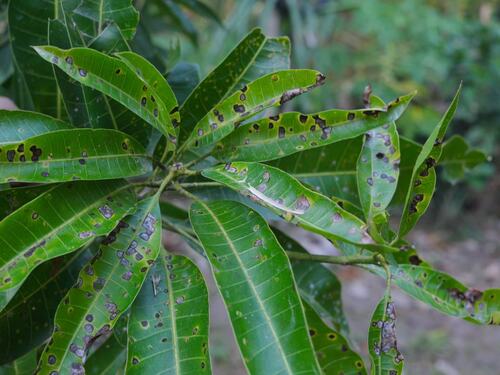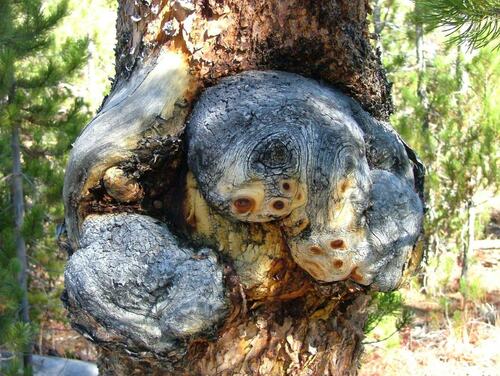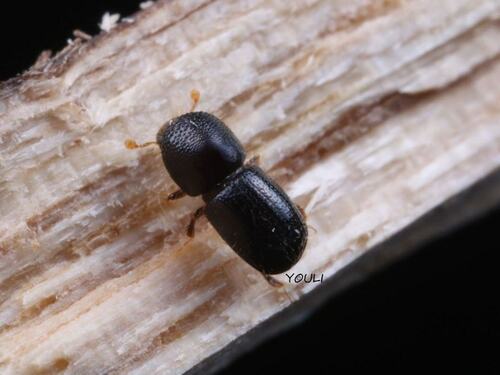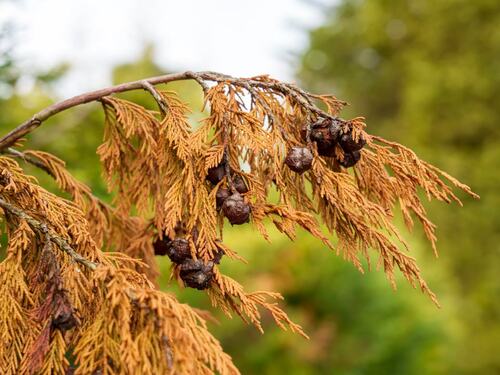10 Common Tree Diseases: Symptoms and Solutions
Introduction
Here in the San Francisco Bay Area, we’re lucky to enjoy an incredibly rich and diverse urban forest. Our mild Mediterranean climate is ideal for a whole host of tree species, not least the absolutely magnificent natives—coast redwoods, Douglas firs, Pacific madrones, bay laurels, live oaks, and more—that help define the California coast.
At Arborist Now, we help actively care for this urban forest—including addressing the tree pests and diseases that, unfortunately but unsurprisingly, are also varied and diverse in this area. In this article, we’ll run through how to identify tree diseases and plant pathology issues you may run into in our part of California, plus common tree disease treatments. Let’s get going!
1. Fire Blight

Early Signs of Fire Blight on a Fruit Tree
Fire blight, so named because of the scorched-looking foliage, blossoms, and fruit it produces, stems from a bacterium, Erwinia amylovora. It commonly afflicts apples, pears, crabapples, quince, and other fruit trees, and in severe cases, it may kill whole branches or even a complete tree.
Symptoms
You’ll typically key into fire blight in spring, when warmer weather spurring renewed tree growth kicks bacteria—which overwinter in cankers—into action. An easy-to-miss early sign is tannish ooze leaking from the bark cankers and staining the wood black. Rainwater, irrigation, and insects then spread that bacterial liquid onto succulent young shoots and spring flowers, whereupon pollinators become important vectors.
Infected blossoms, shoots, and fruit begin wilting and turn a brown or black hue. Fire blight can also spread into twigs and boughs; this infected wood turns orangish, pinkish, or reddish beneath the bark.
Solutions
Inspect fruit trees in winter for signs of fire blight cankers and infected twigs and deal with these before spring. Prune diseased wood several inches below visible signs of infection; you may be able to cut out cankers from larger boughs. Some growers use blossom sprays to prevent new infections.
2. Sudden Oak Death
An introduced fungus-like “water mold,” Phytophthora ramorum , causes the infamous canker disease known as Sudden Oak Death , which first came on the scene in the Golden State back in the 1990s. Among the more notorious forest tree diseases in our region, it can also impact rural, urban wildland interface, and even residential areas.
P. ramorum can cause leaf spots and twig dieback on a wide variety of trees and shrubs, including California bay laurel, madrone, and rhododendron. These aren’t typically seriously affected by the disease, however. It’s when Sudden Oak Death infects the bark of oak trees, including tanoaks, that things really get nasty: The resulting cankers eventually girdle the oak, rotting out the wood and ultimately killing the host. The rapid rate at which the canopy browns and dies after canker girdling explains the disease’s common name.
Symptoms
Cankers typically develop on the lower trunks and sometimes lower boughs of infected oaks. In tanoaks and canyon live oaks, Sudden Oak Death may also produce the foliage lesions and twig diebacks seen in non-oak hosts. Cankers often (but not always) leak a rusty or blackish sap.
Solutions
Unfortunately, there’s no known effective treatment of Sudden Oak Death once an oak tree is infected. Whether the tree should be removed or not depends on a variety of factors; oaks may survive several years with the disease. Seek a professional arborist’s advice to figure out the best way to proceed.
Although bay laurels and other secondary hosts are thought to be important in spreading Sudden Oak Death to oak trees, wholesale removal of such trees or shrubs isn’t usually advised. In areas where the disease is known to be present, you might consider removing or pruning back a secondary host plant that’s close to a potentially vulnerable oak.
3. Anthracnose

A Closeup of Leaves with Black Spots Due to Anthracnose Infection
Anthracnose is a catchall name for a blight caused by a number of different fungus species. It infects a whole slew of trees, including sycamores, ashes, oaks, dogwoods, and willows.
The fungi causing anthracnose overwinter in leaf litter and then spread spores in spring to young leaves and shoots. Extended periods of cool and wet weather in springtime are particularly favorable for anthracnose proliferation. It causes foliage lesions and can deform twigs, though in most cases the disease isn’t fatal.
Symptoms
Infected leaves typically show dark lesions, though the pattern of these spots varies between tree species, and the leaves may also curl.
Anthracnose most typically impacts the lower part of the tree crown; severely infected trees may show a normal canopy top above defoliated lower branches. Dense masses of shoots (“witches’ brooms”) occasionally result. Chinese elms infected with anthracnose often develop bark cankers.
Management
Prune infected twigs and branches in winter. You can also attempt to prevent infection in the first place by clearing away the leaf litter that shelters the culprit fungi during winter.
4. Raywood Ash Canker & Decline/Dieback
Raywood (or claret) ashes are widely cultivated for their dazzling fall colors, handsome form, and speedy growth. It’s not uncommon for them to suffer from what’s often called Raywood ash canker or Raywood ash dieback, which is ultimately caused by a fungus ( Botryosphaeria stevensii ) that generally gains a foothold due to environmental—particularly water—stress.
As such, it’s a good example of why improper care and maintenance of a tree are, in so many cases, the main reasons why it becomes infected with a pathogen of some kind. Trees hampered by drought, crowding, or other stressors tend to be more susceptible to disease, including from pests that otherwise wouldn’t cause much trouble.
Raywood ash canker usually doesn’t completely kill an infected tree, but it can cause all kinds of problems nonetheless. Dead infected limbs become a safety and structural hazard, and the depletion of the canopy reduces the shade cast by the ash.
Symptoms
Raywood ash canker kills limbs in the ash canopy, with pockets of dead wood and withered, browned foliage as a giveaway. Infected branches show brownish cankers first, then cracked bark.
Management
Make sure your Raywood ash is receiving adequate water, particularly during the summer dry season. Selective pruning may further reduce water stress and enhance tree vigor.
5. Crown Gall

A Large Crown Gall Growth on a Tree Trunk – Image by Extremis from Pixabay
Crown gall, caused by Agrobacterium bacteria, affects a huge variety of both woody and herbaceous plants, including nut trees, fruit trees, and willows. The disease gets its name from the galls—abnormal swollen growths —that commonly develop at the base of the tree crown (the aboveground portion of the plant), though roots are often affected as well.
Indeed, roots and the bottom of the trunk where it contacts the ground are among the main pathways into the tree for the soil-dwelling bacteria that cause crown gall. Infection often occurs at sites of damage, such as frost cracks, pruning sites, and scrapes from careless mowing.
Usually not a major issue for mature trees, crown gall can be a significant cause of stunting and even death in young trees such as walnuts or apples, as the galls can interfere with the transport of nutrients and water.
Symptoms
Tumor-like galls atop exposed roots or at the base of the trunk suggest infection by crown gall. These galls—initially spongy, but soon hardening into tough woodiness—can also develop further up the trunk or on branches as well.
Solutions
Galls may be carefully cut or torched off to treat crown gall; bactericide is sometimes used as well. Severely stunted, gall-ridden young trees generally ought to be removed.
Following proper pruning techniques and avoiding mechanical damage to tree trunks and roots are some common-sense ways to prevent crown gall infection.
6. Oak Branch Dieback
Two kinds of Diplodia fungi cause oak branch dieback , seen in many of our native and nonnative oaks alike. This disease tends to occur after multiple years of below-average precipitation and drought.
Symptoms
Depending on which Diplodia fungus you’re dealing with, symptoms of oak branch dieback can include canker growths, bark cracking, crown thinning, and dieback of twigs and small branches. Patches of wilting leaves typically develop. You may see small, raised, dark fungal fruiting bodies on the bark of infected trees. Peeling back the bark around those fruiting bodies, or around cankers, reveals dark, dead patches of wood.
Solutions
In drought years, consider supplemental rainy-season/winter watering of oaks to ward off oak branch dieback.
7. Invasive Shot Hole Borer/Fusarium Dieback Complex

A Close-up of a Shot Hole Borer Beetle – Photo from Wikimedia Commons
There’s currently a big-time effort to control the spread of Invasive Shot Hole Borers (ISHBs)—a couple of species of tiny nonnative beetles—in California, as they’re among the more worrisome insect pests on the radar. The beetles tunnel into the bark of many different kinds of trees—including such California natives as oaks, cottonwoods, boxelders, bigleaf maples, sycamores, and buckeyes—and excavate deep galleries, which weakens wood and can disrupt water and nutrient flow. Not only that, but ISHBs spread Fusarium fungi that can cause serious disease in trees (Fusarium dieback).
The “ISHB/Fusarium dieback complex” spread into Southern California in the early 2000s and has proliferated rapidly. It’s now known as far north as the Central Coast, and we all should be on the lookout for it in the Bay Area.
Symptoms
The entry holes of ISHBs are very small—we’re talking pen-tip size—and round (hence “shot hole”). While the holes themselves are pretty inconspicuous, they’re often surrounded by wet, stained, or crusted bark. While symptoms vary depending on the host tree, the combination of beetle tunneling and fungal spread usually results in loss of vigor and extensive dieback. Heavily infected trees pose a major hazard, given all the deadwood.
Solutions
Prune infected branches and, ideally, chip them down to pieces that are an inch or less. Solarize this mulch if you plan to spread it.
Avoid transporting firewood or wood waste—which may be infected—long distances to do your part in containing this serious pest/disease combo!
8. Scab
Various fungi (including Fusicladium and Venturia ) cause scab , common hosts of which include pears, apples, crabapples, willows, and olives. This disease is generally worst during especially wet springs.
Symptoms
Leaves with scab infection typically first show yellowish spots, then darker discolorations, sometimes with fuzzy growths, and curling or twisting. Infected fruits bear lesions and may crack. Scab-afflicted foliage, fruits, and flowers may also drop early.
Solutions
Scab fungi overwinter in fallen leaves (as well as in evergreen foliage), so remove/compost ground litter. Thinning the canopy of vulnerable trees can sometimes prevent scab infection because this facilitates greater airflow within the crown and reduces humidity (high levels of which promote scab).
9. Cypress Canker

A Cypress Branch Killed by Cypress Canker Disease
San Francisco was among the first areas in which cypress canker , a fungal disease spread by Seiridium cardinale , was formally documented. It can affect a variety of conifers, including arborvitae and juniper, but is most prevalent in trees of the Cupressus genus, including Monterey cypress—native to a small area along California’s Central Coast but widely planted on the West Coast—and Leyland cypress.
A tree very popular in landscaping but with loads of issues, Leyland cypress is very susceptible to cypress canker. Monterey cypress doesn’t suffer from the disease in its native range or generally in other parts of the immediate California coast, where the cool maritime climate seems to make it resilient. But where Monterey cypress is planted farther inland—including warmer, drier parts of the interior Bay Area—it’s often infected.
Symptoms
Cypress canker manifests as oozy lesions on the bark and can eventually girdle and kill limbs. Extensive browning, reddening, or yellowing of the canopy due to dead boughs and foliage is a hallmark. It’s not uncommon for the disease to eventually kill the whole tree.
Solutions
Pruning infected wood and cutting or scorching out cankers are among the treatments for cypress canker, though often an infected tree is, unfortunately, on a one-way road to decline. Avoid planting Leyland cypress or, in drier inland areas, Monterey cypress; there are similar-looking alternatives, such as incense-cedar, which tend to be more resistant to the disease.
10. Peach Leaf Curl
This is another fungal disease—one that’s restricted to peaches and nectarines . As the name suggests, it causes curling of foliage, though it can also affect shoots, twigs, and (rarely) fruit. As with a number of other fungal issues, it’s especially associated with extended cool, wet weather in springtime.
Although infected trees often regrow a new set of leaves that, unless the wet stretch continues, are usually normal, that shortens the growing season and taxes the tree’s energy reserves. Prolonged, recurring peach leaf curl can severely weaken or even kill a tree over time.
Symptoms
Leaves infected with peach leaf curl first show reddish areas soon after spring growth, then begin twisting; they’ll ultimately yellow and may drop. Similar distortions sometimes occur in green shoots.
Solutions
Infected trees can be treated with fungicide. But you can avoid the problem altogether by planting leaf-curl-resistant varieties of peaches and nectarines.
Get Expert Arborist Advice & Treatment for Bay Area Tree Diseases From Our Team
From consultations on preventing tree diseases naturally to treating infections and, if necessary, removing afflicted wood or entire trees, look no further than Arborist Now for the finest in Bay Area tree care! Get in touch and obtain a free estimate!


